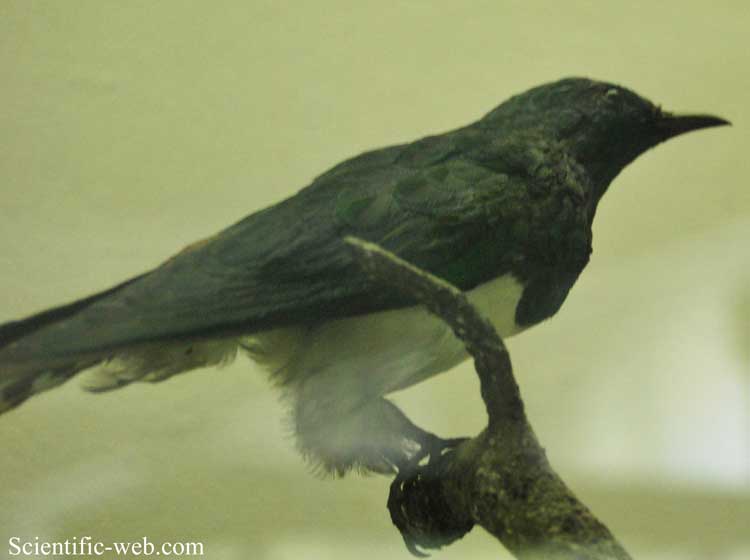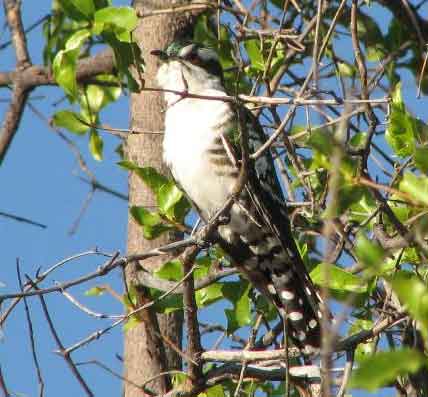
Chrysococcyx caprius, Photo: Michael Lahanas
Superregnum: Eukaryota
Cladus: Unikonta
Cladus: Opisthokonta
Cladus: Holozoa
Regnum: Animalia
Subregnum: Eumetazoa
Cladus: Bilateria
Cladus: Nephrozoa
Superphylum: Deuterostomia
Phylum: Chordata
Subphylum: Vertebrata
Infraphylum: Gnathostomata
Megaclassis: Osteichthyes
Cladus: Sarcopterygii
Cladus: Rhipidistia
Cladus: Tetrapodomorpha
Cladus: Eotetrapodiformes
Cladus: Elpistostegalia
Superclassis: Tetrapoda
Cladus: Reptiliomorpha
Cladus: Amniota
Classis: Reptilia
Cladus: Eureptilia
Cladus: Romeriida
Subclassis: Diapsida
Cladus: Sauria
Infraclassis: Archosauromorpha
Cladus: Crurotarsi
Divisio: Archosauria
Cladus: Avemetatarsalia
Cladus: Ornithodira
Subtaxon: Dinosauromorpha
Cladus: Dinosauriformes
Cladus: Dracohors
Cladus: Dinosauria
Ordo: Saurischia
Cladus: Eusaurischia
Subordo: Theropoda
Cladus: Neotheropoda
Cladus: Averostra
Cladus: Tetanurae
Cladus: Avetheropoda
Cladus: Coelurosauria
Cladus: Tyrannoraptora
Cladus: Maniraptoromorpha
Cladus: Maniraptoriformes
Cladus: Maniraptora
Cladus: Pennaraptora
Cladus: Paraves
Cladus: Eumaniraptora
Cladus: Avialae
Infraclassis: Aves
Cladus: Euavialae
Cladus: Avebrevicauda
Cladus: Pygostylia
Cladus: Ornithothoraces
Cladus: Ornithuromorpha
Cladus: Carinatae
Parvclassis: Neornithes
Cohors: Neognathae
Cladus: Neoaves
Ordo: Cuculiformes
Familia: Cuculidae
Genus: Chrysococcyx
Species: Chrysococcyx caprius
Name
Chrysococcyx caprius (Boddaert, 1783)

Chrysococcyx caprius (*)
References
Table des Planches Enluminéez d'Histoire Naturelle de M. D'Aubenton. p. 40
Vernacular names
Afrikaans: Diederikkie
čeština: Kukačka lesklá
English: Dideric Cuckoo
Esperanto: Orkukulo
español: Cuclillo didric
suomi: Kuparikäki
français: Coucou didric
Türkçe: Dideric guguğu
The diederik cuckoo (Chrysococcyx caprius), formerly dideric cuckoo or didric cuckoo is a member of the cuckoo order of birds, the Cuculiformes, which also includes the roadrunners and the anis.
Taxonomy
The diederik cuckoo was described by the French polymath Georges-Louis Leclerc, Comte de Buffon in 1780 in his Histoire Naturelle des Oiseaux from a specimen collected in the Cape of Good Hope region of South Africa.[2] The bird was also illustrated in a hand-coloured plate engraved by François-Nicolas Martinet in the Planches Enluminées D'Histoire Naturelle which was produced under the supervision of Edme-Louis Daubenton to accompany Buffon's text.[3] Neither the plate caption nor Buffon's description included a scientific name but in 1783 the Dutch naturalist Pieter Boddaert coined the binomial name Cuculus caprius in his catalogue of the Planches Enluminées.[4] The diederik cuckoo is now placed in the genus Chrysococcyx that was erected by the German zoologist Friedrich Boie in 1826.[5][6] The species is monotypic.[6]
The generic name Chrysococcyx combines the Ancient Greek khrusos meaning "gold" and kokkux meaning "cuckoo". The specific epithet caprius is from the Latin cupreus meaning "coppery".[7] The common name "diederik" is from Afrikaans "diedrik", an onomatopoeic rendition of the bird's call.[8]
Description
At Rietvlei Nature Reserve, Gauteng, South Africa
The diederik cuckoo is a smallish cuckoo at 18 to 20 cm. Adult males are glossy green above with copper-sheened areas on the back and whitish underparts. They have a broken white eye-stripe and a short, green malar stripe. All remiges have three to four white spots on the inner vanes. The four green outer tail feathers are tipped white, and the outermost pair are spotted white on both vanes.
Females show more copper above, and have coppery barring on the flanks. The underparts are often washed brownish.
Juveniles have a red bill, streaky throat and a white wing-bar. They are more copper-coloured above and browner below than the females, and the flank markings are brown blotches.
Behaviour
Breeding
The diederik cuckoo is a brood parasite.[9] It lays a single egg mostly in the nests of weavers, especially the village weaver and the bishops in the genus Euplectes. For example, it has been recorded in red-collared widowbirds.
Feeding
The diederik cuckoo takes a variety of insects and caterpillars. It is a noisy species, with the persistent and loud deed-deed-deed-deed-er-ick call from which it gets its name. Usually four clear, roughly identical, notes followed by a little twitter.
Distribution and habitat
It is a common resident breeder in Sub-Saharan Africa and the southern Arabian Peninsula. It has been recorded as far north as Cyprus (1982). It is a short-distance seasonal migrant, moving with the rains. It is a solitary bird, found in open woodland, savanna and riverside bushes.
References
BirdLife International (2016). "Chrysococcyx caprius". IUCN Red List of Threatened Species. 2016: e.T22684026A93011786. doi:10.2305/IUCN.UK.2016-3.RLTS.T22684026A93011786.en. Retrieved 12 November 2021.
Buffon, Georges-Louis Leclerc de (1780). "Le coucou vert-doré et blanc". Histoire Naturelle des Oiseaux (in French). Vol. 12. Paris: De L'Imprimerie Royale. pp. 42–44.
Buffon, Georges-Louis Leclerc de; Martinet, François-Nicolas; Daubenton, Edme-Louis; Daubenton, Louis-Jean-Marie (1765–1783). "Coucou verde, du Cap du bonne-Esperance". Planches Enluminées D'Histoire Naturelle. Vol. 7. Paris: De L'Imprimerie Royale. Plate 657.
Boddaert, Pieter (1783). Table des planches enluminéez d'histoire naturelle de M. D'Aubenton : avec les denominations de M.M. de Buffon, Brisson, Edwards, Linnaeus et Latham, precedé d'une notice des principaux ouvrages zoologiques enluminés (in French). Utrecht. p. 40, Number 657.
Boie, Friedrich (1826). "Generalübersicht der ornithologischen Ordnungen, Familien und Gattungen". Isis von Oken (in German). 19. Cols 969–981 [977].
Gill, Frank; Donsker, David, eds. (2019). "Turacos, bustards, cuckoos, mesites, sandgrouse". World Bird List Version 9.2. International Ornithologists' Union. Retrieved 20 July 2019.
Jobling, James A. (2010). The Helm Dictionary of Scientific Bird Names. London: Christopher Helm. pp. 90, 105. ISBN 978-1-4081-2501-4.
"didric". Merriam Webster Dictionary. Retrieved 21 July 2019.
Davies, N. B. (2015). Cuckoo : cheating by nature. New York, NY: Bloomsbury USA, an imprint of Bloomsbury Publishing Plc. pp. 127–130. ISBN 978-1620409527.
Further reading
Birds of The Gambia by Barlow, Wacher and Disley, ISBN 1-873403-32-1
Retrieved from "http://en.wikipedia.org/"
All text is available under the terms of the GNU Free Documentation License

